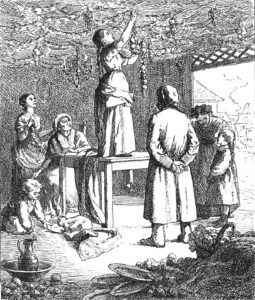Auguste Widal’s Jewish writings from the 1840s and 1850s recall the traditions he grew up with in a French village in the early 19th century. Here are excerpts from “Sukkoth and a Betrothal.”
AUTUMN IS THE SEASON when Jewish holidays are most plentiful. September had returned with its cool, misty mornings and longer evenings, and I had not left Alsace. I was in Hegenheim, a village on the Swiss border just one league from Basle. There I would celebrate a holiday that had given me the loveliest memories ever since childhood: Sukkoth, also called the Feast of Tabernacles or of Booths. Hegenheim has had a large Jewish population since time immemorial, made up of cattle merchants, peddlers and clockmakers who all do business in and with Switzerland. A kind and honest clockmaker friend of Papa Salomon’s, little Aron, had offered me his hospitality. I arrived at his home as promised, the day before the holiday.
For the ancient Israelites, Sukkoth had both agricultural and historical meaning. Agriculturally, it marked the end of the harvests, the gathering of all the fruit of the trees and the vine. Also, presumably as a symbol of the harvest, the Law required people to bring a bundle of several plants to the Temple on the first day of the holiday. Historically, Sukkoth commemorates the Israelites’ wanderings in the desert, in memory of which they must live in temporary dwellings for seven days each year at this season. Hence Feast of Tabernacles or Booths.
All of this is obeyed rigorously in our countryside. Three days before the holiday, everywhere in the village, such bustle and activity! Men, lads and little boys all work on the sukkah or booth. In every courtyard, on every corner, in every little square, they build rustic shelters for themselves and their Continue reading

